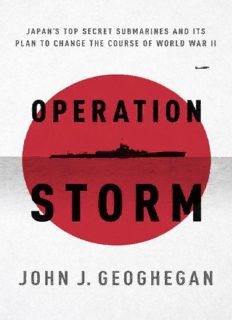
Operation Storm: Japan's Top Secret Submarines and Its Plan to Change the Course of World War II PDF
Preview Operation Storm: Japan's Top Secret Submarines and Its Plan to Change the Course of World War II
Copyright © 2013 by John Geoghegan All rights reserved. Published in the United States by Crown Publishers, an imprint of the Crown Publishing Group, a division of Random House, Inc., New York. www.crownpublishing.com CROWN and the Crown colophon are registered trademarks of Random House, Inc. Library of Congress Cataloging-in-Publication Data is available on request. eISBN: 978-0-307-46481-1 Illustrations by Emil Petrinic Jacket design by Eric White v3.1 For Emma and Nina, because it’s always better to know both sides C ONTENTS Cover Title Page Copyright Dedication Author’s Note Principal Actors Map P I PROLOGUE ART Chapter 1 FACE-OFF Chapter 2 THE I-401 P II PREPARATION ART Chapter 3 BIRTH Chapter 4 NAMBU Chapter 5 UNDERWATER AIRCRAFT CARRIERS Chapter 6 PROOF OF CONCEPT Chapter 7 CHALLENGES P III COMPLICATIONS ART Chapter 8 REDUCTION AND REVIVAL Chapter 9 NAMBU UNDER FIRE Chapter 10 NAMBU BECOMES A MOLE Chapter 11 SEIRAN TAKES FLIGHT Chapter 12 THE PANAMA CANAL Chapter 13 ARIIZUMI Chapter 14 ARIIZUMI UNDER FIRE Chapter 15 THE SEGUNDO (SS 398) Chapter 16 DECLINE P IV THE MISSION ART Chapter 17 NAMBU AND THE I-401 141 Chapter 18 THE 631ST Chapter 19 FULP ON PATROL Chapter 20 KURE Chapter 21 ADVERSITY Chapter 22 ATTACKING THE CANAL Chapter 23 GREEN LIGHT Chapter 24 FULP’S LAST PATROL Chapter 25 NANAO BAY Chapter 26 THE TASTE OF PERSIMMON Photo Insert Chapter 27 JOHNSON TAKES COMMAND Chapter 28 OPERATION STORM P V RACE AGAINST TIME ART Chapter 29 DEPARTURE Chapter 30 UNDER WAY Chapter 31 CROSSED WIRES Chapter 32 THE EMPEROR’S VOICE Chapter 33 ANARCHY Chapter 34 ESCAPE Chapter 35 INTERCEPTION Chapter 36 SPOILS OF WAR Chapter 37 RECKONING Chapter 38 BOARDING PARTY Chapter 39 THE TENTH WAR GOD Chapter 40 BITTERSWEET Chapter 41 FREEDOM Chapter 42 THE LONG ROAD HOME Chapter 43 REDISCOVERY E PILOGUE Acknowledgments Notes Sources ’ A N UTHOR S OTE Under the supervision of the Demobilization Bureau, the basic material contained in this monograph was compiled and written in Japanese by former officers … The paucity of original orders, plans and unit journals, which are normally essential in the preparation of this type of record, most of which were lost or destroyed during field operations or bombing raids rendered the task of compilation most difficult … However, while many of the important orders, plans and estimates have been reconstructed from memory and therefore are not textually identical with the original, they are believed to be generally accurate and reliable. —Japanese Operational Monograph, JAPANESE RESEARCH DIVISION, MILITARY HISTORY SECTION, HEADQUARTERS, ARMY FORCES FAR EAST, 1946, PREFACE, P. V. RASHOMON IS A JAPANESE TERM THAT DESCRIBES HOW DIFFERENT witnesses to the same event can shape its story differently, based on individual perception. Rashomon also applies to the history of the I-400 submarines because the memories of their officers and crew sometimes differ. As the preface to the Allied monograph on Japanese military history indicates above, many Japanese records were destroyed during or immediately after the war. As a result, I have relied primarily on first-person accounts either oral or written. When accounts differ, I have indicated the differences in a footnote. Additionally, Japanese records show an event happening a day later than U.S. records. This is because Japanese time is 13 to 16 hours ahead of U.S. time, depending on the U.S. time zone and daylight savings. For example, the attack on Pearl Harbor happened on Monday, December 8, in Japan, but the date is emblazoned in American memory as Sunday, December 7. The fact that many Japanese records were lost, or intentionally destroyed, at the end of the war means dates can be difficult to establish. When dates are in conflict or doubt, a footnote explains the difference. Any errors are my own. Finally, Japanese names appear in Western style, with the family name coming last. In the interest of simplicity, I have also omitted any macrons. Ages are also stated in Western terms. (Prior to World War II, Japanese children were considered one year old when they were born.) And though the Japanese do not refer to ships as male or female, I have done so throughout the text to maintain consistency with Western convention. P A RINCIPAL CTORS IMPERIAL JAPANESE NAVY (IJN, OR DAI-NIPPON TEIKOKU KAIGUN) NAVAL GENERAL STAFF (GUNREIBU) • Cdr. Yasuo Fujimori, staff officer submarines. He was dedicated to steering the I-400 program through a hostile bureaucracy. • Cdr. Shojiro Iura, staff officer submarines. He opposed the I- 400 program, even though he wanted to bomb Oregon. COMBINED FLEET (RENGO KANTAI) • Adm. Isoroku Yamamoto, commander in chief of the Combined Fleet. He dreamed up the I-400 submarines as a follow-up punch to Pearl Harbor. • Capt. Kamato Kurojima, Yamamoto’s chief staff officer. He helped make sure a resistant naval bureaucracy built Yamamoto’s underwater aircraft carriers. SIXTH FLEET (IJN SUBMARINE FORCE, OR Dai-roku Kantai) Submarine Squadron 1 (SubRon 1, or Daiichi Sensuitai), sometimes called Sensuikan tokugata (Special submarine), or Sen-toku for short. In some instances the I-400 submarines were also referred to as tokugata, or “special model” subs.1 • Cdr. Tatsunosuke Ariizumi, squadron commander. The British may have called him “the Butcher,” but his reputation inside the Imperial Japanese Navy was just as tough. I-401 (SQUADRON FLAGSHIP) KEY OFFICERS AND CREW • Lt. Cdr. Nobukiyo Nambu, commanding officer. The emotional
Description: